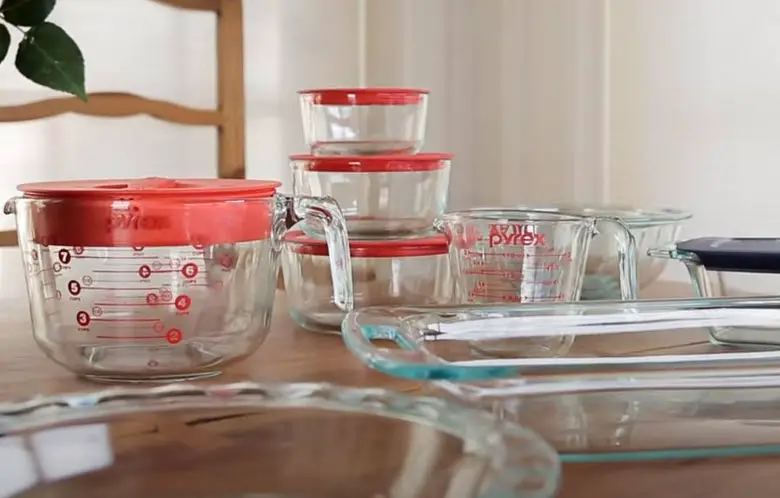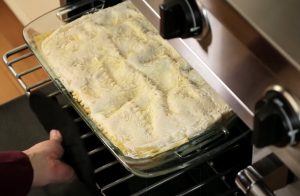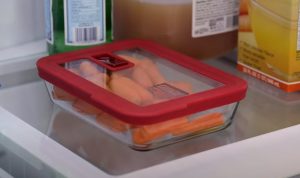Your kitchen equipment and utensils are just as crucial as your diet when it comes to good health. The cookware you use significantly impacts the quality of food that comes from your kitchen. You don’t have to be a master chef to be concerned about your cookware and its functions. This is particularly common with glass cookware, such as Pyrex Glass. What exactly is Pyrex glass? Will it shatter in your oven’s heat? Is it as hot as glass when it comes into contact with food? How do you clean it up afterward? Can Pyrex glass go in oven? These are typical concerns when it comes to Pyrex glass cookware.
We’ve put together this article to answer some of your Pyrex glass-related questions. Continue reading.
What is Pyrex Glass?
 Pyrex glass is not ordinary glass, as you might have guessed. Pyrex glass, also known as borosilicate glass, is thermal shock-resistant glass. It is made of borosilicate glass, which can withstand many things that silicate, also known as regular glass, cannot. It can withstand thermal shock up to 210°.
Pyrex glass is not ordinary glass, as you might have guessed. Pyrex glass, also known as borosilicate glass, is thermal shock-resistant glass. It is made of borosilicate glass, which can withstand many things that silicate, also known as regular glass, cannot. It can withstand thermal shock up to 210°.
Pyrex glass is used for thermometers, industrial equipment, and cookware because of its high resistance to electricity, heat, and chemicals. Pyrex glass’s toughness makes it ideal for a variety of kitchen applications. There is rarely a kitchen that does not have various types of Pyrex glass cookware.
It is designed to be unaffected by electricity, heat, or chemicals. When heated, Pyrex glass does not expand as much as regular glass. The expansion of the regular glass in response to heat is approximately three times that of Pyrex glass.
Pyrex glass is not easily broken. It is not an exaggeration to say that Pyrex glass is the most durable and sturdy glass variant.
How Is Pyrex Glass Made?
The fact that Pyrex glass has different qualities than regular glass is reason enough to wonder, ‘how is Pyrex glass made?’ Seeing as Pyrex glass is unique, it is only natural that it is not manufactured in the same way as regular glass.
Pyrex glass is made from a variety of materials. Stabilizers, formers, and fluxes are the three materials used to make Pyrex glass.
These materials help the glass remain intact. Stabilizers, as the name implies, allow glass products to remain stable without crumbling or breaking apart. The formers are the materials that are used to make glass. They are crystal-like materials that are heated, melted, and cooled to form glass. Temperature is reduced by using fluxes. This is done to ensure that the formers melt and produce glass.
Aluminum, silicon, sodium, and silicon oxides are the primary components of glass. Raw materials such as alumina, pure sand, soda, and bore are included in these ingredients. The glass oven is heated to approximately 150°C to melt the previously combined ingredients. The result is a transparent molten rock or lava. CO2 bubbles are removed, and Pyrex glass is created after other technical procedures!
What Makes Pyrex Glass Unique?
You may have noticed the hype surrounding Pyrex glass cookware and wondered why it is so popular. You might even have a few Pyrex glass cookware pieces in your kitchen, but you just see them as regular.
The truth is that Pyrex glass cookware differs from standard cookware in numerous ways. The features that make Pyrex glass unique are:
Durability
Everyone understands that glass is a fragile material, which is why you pay special attention to them. Pyrex glass cookware is far more durable than other types of cookware. They are specifically designed to withstand scratches and a variety of accidents.
Pyrex glass cookware, on the other hand, can last for years and even generations without losing value.
Thickness
Pyrex glass cookware tends to be heavier than cookware made of other materials. Pyrex materials are thick for a reason; they are designed to withstand a variety of conditions.
Rarity
Pyrex glass cookware is always in high demand as a valuable product. Hence, they are not always readily available. You should cherish your Pyrex glass pots even more because replacing them may not be as simple as you think.
Is Pyrex Glass Safe?
It can be difficult to determine whether Pyrex glass is safe. Pyrex glass has a wide range of properties, and it is natural to have one or two flaws. We conducted extensive research to determine the safety concerns that may arise from the use of Pyrex glass cookware.
In general, using Pyrex glass in the kitchen poses no safety risks. This means that you can be confident in the safety of Pyrex glass cookware.
Pyrex glass, as previously stated, is fireproof. It is also an electrical insulator, meaning electricity cannot pass through.
However, you should still read the manufacturer’s instructions for your Pyrex glass cookware.
What Types of Cookware are made with Pyrex Glass?
Pyrex is a trademarked material that is made up of a number of different types of glass. It can be used for baking, cooking, and even storage. Contrary to popular belief, it can be used for much more than just making kitchen bowls. It’s long-lasting and simple to clean.
Pyrex glass can be used to make the following types of cookware:
- Mixing and storage bowls
- Pots
- Cups
- Pans
- Oven dishes
- Kitchen utensils
- Bakeware
Pyrex glass is not just for use in the kitchen. This reusable glassware can also be used in the garage, on the patio, or even at home in your dorm room (if you’re into that kind of thing).
Pyrex is a household name for good reason. It’s durable, reliable, and versatile — especially compared to other glass cookware available on the market today.
What is the temperature threshold for Pyrex glass?
The heating limit of Pyrex is not just the temperature at which the glass will break but also the temperature at which it will start to fuse.
The two are related: if you heat a piece of Pyrex above its melting point, it’ll start to melt slowly and become more viscous, but it’ll still have some resistance to further heating. This means you can use a higher temperature than its melting point (to get a thinner glass), but still not melt it completely.
To be clear, this doesn’t mean that you can use any heat source to melt your Pyrex; these glasses are made from borosilicate glass, which is extremely hard and brittle and will shatter if heated too much.
Can Pyrex Glass Go in Oven?
No matter how strong it is, Pyrex glass is still a member of the ‘glass’ family. As a result, it cannot be treated in the same way that stainless steel or plastic can.
 Pyrex glass can be used in the oven. However, it is important to note that Pyrex glass can mostly be used in a preheated oven. The glass may shatter if your oven has not been preheated. While some Pyrex glass can be used in an unheated oven, many others cannot. This is why it is critical to determine whether your Pyrex glass can be used in a non-preheated oven.
Pyrex glass can be used in the oven. However, it is important to note that Pyrex glass can mostly be used in a preheated oven. The glass may shatter if your oven has not been preheated. While some Pyrex glass can be used in an unheated oven, many others cannot. This is why it is critical to determine whether your Pyrex glass can be used in a non-preheated oven.
Preheating your oven before inserting your Pyrex glass cookware is always a good idea. While heating, the oven emits some elements harmful to Pyrex glass. In any case, it is always better to be safe than sorry.
If your Pyrex glass cookware has cracks or is chipping off at the edges, it is beginning to deteriorate. It should never be put in the oven because it can shatter at any time.
Can Pyrex Lids Go in Oven?
“Can Pyrex lids go in the oven?” The answer is determined by the type of lid on your Pyrex cookware. It’s worth noting that just because your Pyrex bowl is glass doesn’t mean the lid is, too. Glass lids are not standard on all Pyrex cookware. Only a few Pyrex cookware pieces have glass lids.
Most Pyrex cookware lids serve primarily as protection and storage. For example, if you need to keep food in the freezer but don’t want to leave it open. This explains why the majority of Pyrex pots, pans, and bowl lids are made of plastic.
So, if your Pyrex lid is made of plastic, you should avoid putting it in the oven. The heat from the oven will almost certainly melt the plastic. This will create an unnecessary mess and most likely impact the quality of your food.
You can use aluminum foil instead of a plastic lid. This will still provide adequate coverage for your food. There will be no melting at the same time.
However, if your Pyrex lid is made of Pyrex glass (as is usually the case with casserole dishes), you can put it in the oven as long as it is preheated.
Is Pyrex Glass Safe to Use In A Toaster Oven?
While Pyrex glass is safe to use in a preheated oven, it is not safe in a toaster oven. Pyrex glass has a heat resistance limit of 425°. The heat exceeds its ability to withstand or resist, causing the glass to shatter. This renders it unfit for use in a toaster oven. The same is true for using it in a broiler.
Is It Safe to Use Pyrex Bowls in the Oven?
Pyrex glass bowls are strikingly different from Pyrex glass pans or pots. Although they are made of the same glass, the manufacturing process is different. The majority of Pyrex glass bowls are not oven safe. Before putting your Pyrex bowl in the oven, check the written instructions on the bottom.
Can I Pour Boiling Water into Pyrex Glass Cookware?
 Boiling water should not be poured into all types of kitchen equipment. Boiling water melts rubber and causes cracks in regular glass. This is yet another feature that distinguishes Pyrex glass from other types of kitchenware.
Boiling water should not be poured into all types of kitchen equipment. Boiling water melts rubber and causes cracks in regular glass. This is yet another feature that distinguishes Pyrex glass from other types of kitchenware.
Boiling water can be poured into Pyrex glass cookware. The main reason is that Pyrex glass can withstand boiling water temperatures. There is one thing you should keep in mind about this. The temperature difference should be taken into account. For example, if you just took your Pyrex glass cookware out of the freezer, you should wait a few minutes before pouring boiling water into it. Pouring hot water into cold bowls can gradually weaken the glass.
Can I Put Pyrex Glass Cookware in The Dishwasher?
The answer is no. You should never, under any circumstances, put Pyrex glass in the dishwasher. Glass cookware should never be placed in the dishwasher. The glass may begin to chip or weaken gradually.
Furthermore, it may not be spotless if you use a dishwasher to clean your Pyrex glass cookware.
How Can I Clean Pyrex Glass?
Even though Pyrex glass is highly durable, it is still glass. This implies that you must use extra caution when washing it.
To clean your Pyrex glass cookware, all you need is detergent (preferably clear detergent) and a soft cotton cloth. Your regular sponge’s rough material can scratch the surface of your Pyrex glass cookware. As a result, you should not use it on Pyrex glass.
Wipe the cookware gently, not harshly, with the cloth.
What are the Safety Guidelines for Using Pyrex Glass in The Oven?
 Pyrex glass is an excellent material to use when cooking. The heat doesn’t stick as much to the glass, and it takes much more time to melt it. Typically, Pyrex borosilicate glass is fairly safe for you to use in the oven and won’t break down into toxic chemicals. However, there are some precautions you should take when using Pyrex.
Pyrex glass is an excellent material to use when cooking. The heat doesn’t stick as much to the glass, and it takes much more time to melt it. Typically, Pyrex borosilicate glass is fairly safe for you to use in the oven and won’t break down into toxic chemicals. However, there are some precautions you should take when using Pyrex.
- When heating butter, ensure your Pyrex glass cookware does not stay hot for any longer than the specified time.
- Before putting your Pyrex glass cookware in the oven, allow it to come to room temperature.
- Never pour liquid into Pyrex glass cookware while it is still hot.
Final Thoughts
Pyrex glass cookware is relatively expensive. As a result, it is critical that you take special care of it. No matter how many Pyrex glass pots or bowls you have, you must know how to care for them. Knowing what your cookware can and cannot withstand is an important part of caring for it.
Now that you’ve established that Pyrex glass cookware can be safely used in the oven, you can heat food without fear. You should be fine as long as it is a standard convection oven. Pyrex glass’s heat resistance levels have also been investigated. This puts the ball in your court because you can now decide what is best for your Pyrex glass cookware. More specific limits will be included in the guideline depending on your Pyrex glass cookware manufacturer.
